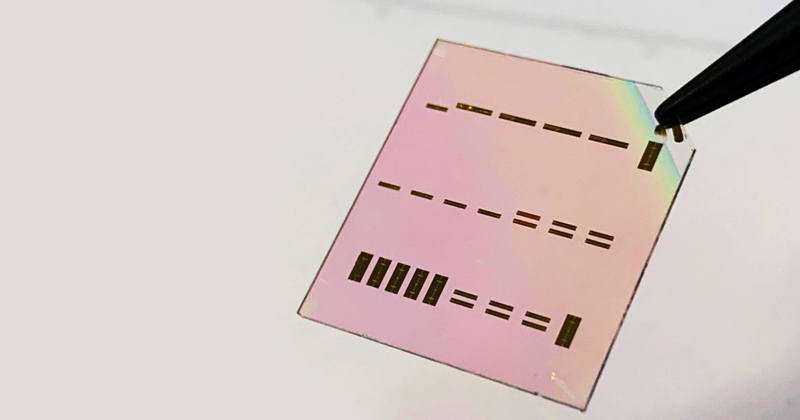Researchers utilize racetrack resonator design in a new scalable platform to achieve high speed and power-efficient light modulation
A research team from the University of Delaware Department of Electrical and Computer Engineeringdemonstrated the first silicon nitride-lithium niobate hybrid electro-optic tunable racetrack resonator with a modified electrode to enhance modulation efficiency. The team presented their work at the OSA (The Optical Society) Advanced Photonics Congress (APC), which was held from July 29 to August 1, 2019, in Burlingame, California. Abu Naim R. Ahmed, a fourth-year doctoral student advised by Engineering Alumni Professor Dennis Prather received a best student paper honor at the OSA APC.

Ahmed testing high frequency RF-photonic devices in Prof. Prather’s research lab.
Silicon and Indium phosphide are popular materials in integrated photonics foundries, however, they are not ideal for ultra-widebandwidth, high-speed phase modulation additionally those materials are not capable of handling high optical input power. Photonic devices of the future will need to employ a wide variety of materials as there is no one material that can do everything well. Therefore, the use of a new material system is desirable to fill in some of silicon and inium phosphides shortcomings. This system combines the electro-optic property of thin-film lithium niobite and low-loss, high optical power handling capacity of silicon nitride.
“My research is focused on energy-efficient optical networks and components for the next-generation photonic integrated circuits (PICs), which has application in the Internet of Things (IoT), on-chip data routers, superconducting quantum computers, artificial intelligence (AI), and 5G networks,” said Ahmed. “All of these next-generation technologies demand low drive power, ultra-wide bandwidth, high-speed data transmission, small footprint, and CMOS compatible fabrication processes. To address these challenges, we have demonstrated a new hybrid material system based a photonic platform by marrying thin-film lithium niobate with silicon nitride. We demonstrated that you can fabricate a tunable and high quality-factor optical micro-ring resonator using conventional microfabrication processes without the need to etch lithium niobate.”
The combination of lithium niobate and silicon nitride enables a high-speed, highly-efficient yet low-power active device. Using the novel modified racetrack structure in this hybrid material platform, electro-optic conversion efficiencies far better than conventional bulk lithium niobate devices is achievable. Moreover, the proposed device is 10 times shorter in length. “Recently using this relatively unexplored material platform, we have also accomplished a sub-volt electro-optic modulator, which has been an illusive goal for more than four decades! We believe this will be a breakthrough in RF-photonic technologies and make this hybrid platform a viable solution for future integrated photonic networks,” Ahmed said.

Doctoral student Abu Naim R. Ahmed in Prof. Dennis Prather’s research group designed a micro-ring and micro-racetrack resonators in hybrid silicon nitride-lithium niobate platform, which have potential for future energy efficient on-chip photonic technologies.
Ahmed came to UD specifically to study with Prof. Prather. “My interest is in silicon photonics and its application on the radiofrequency (RF) side,” said Ahmed. “Dr. Prather is the pioneer in the RF-photonics research field.”

